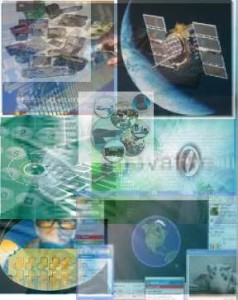Technology – Definition
I used the “Did you Know” YouTube presentation created by Karl Fisch and modified by Scott McLeod. I like it simply because it is a technological presentation, created and broadcast globally through YouTube and because of the information it presents on the information age. The technical aspects it mentions are both the exciting and disturbing aspects mentioned in the Papyrus to Cyberspace broadcast and well as some of the others readings. This presentation reflects that new technologies can be both a positive and ominous force. It also demonstrates the creation and use of technology and how it’s interrelated with life. I find it helps illustrate where and how technology fits in our Western society.
Highlights of the presentation include:
– If Myspace were a country it would be the fifth largest
– The amount of text messages daily exceeds the population of the planet
– There are roughly 540,000 words in the English language ( five times the amount in Shakespeare’s time)
– New amounts of technical information doubles every two years
– Those taking a four year technical degree will find that the information they learned in their first year will be obsolete by the time they graduate
September 14, 2009 2 Comments
General comment on the postings as a learning exercise
Now that we have completed most of the assignments for Module One I would like to comment on the posting to the community weblog. I have found it very interesting to read the highly varied and creative responses of the students. When for example, we were first given the assignment to create two responses to the word text and technology I drew a blank. Other than a dictionary definition I found myself perplexed where I should turn and what I could produce. Then, as people began to post their responses I felt more at ease (less of newbieitis??sp) and began to enjoy the exercise, use my own creativity and benefited immensely from the process. I also have found the form valuable in being able to read all the different ideas, views and opinions as well as engage in discussion and response. It has been a great deal of work but very worthwhile. (Plus, I have learned where to click and how to sign it now and am no longer getting lost somewhere on the cwl. ) As a teacher, I find it an excellent learning tool as there is a place for individual response and group discussion via post. I like it as it requires me to make connections and think critically, while at the same time establishing some impressions of classmates and their views.
September 14, 2009 2 Comments
Text – Definition
Beowulf
The beginning might not be the end. And that night
Grendel cam again, so set
On murder that no crime could ever be enough,
No savage assault quench his lust
For evil. Then each warrior tried
To escape him, searched for rest in different
Beds, as far from Herot as they could find,
Seeing how Grendel hunted when they slept.
Distance was safety; the only survivors
Were those who fled him. Hate had triumphed.
Author unknown
Line 134-143
Translated by Burton Raffel
Signet Classic – New American Library, 1963
For a representation of text my initial thought was Beowulf. For me, Beowulf is one of the ultimate representations of text. This epic poem has an unknown author and is thought to be one of the first documented texts in Anglo-Saxon history. Much debate surrounds this poem as it is thought in many scholarly circles to be a collection of oral stories. Walter J. Ong states in his book, Orality and Literacy, the difference between written literature and oral tradition. He states that “Writing makes ‘words’ appear similar to things because we think of words as the visible marks signalling word to decoders: we can see and touch and inscribed ‘words’ in texts and books. Written words are residue. Oral tradition has no such reside or deposit.” (pg. 11). Thus I see the epic poem Beowulf to be a juxtaposition of text and oral traditions. One of the first written documents in the English language is an illustration of the evolution (weaving and stitching) of written English.
September 14, 2009 No Comments
Defining Technology
The last time I was at UBC it was to complete a degree in Technology Education. Contrary to what you might expect the technology education that I was studying had very little to do with computers. Technology Education was (is) the name adopted for the field that used to be called Industrial Education. I suppose the name was chosen in an attempt to make the area more in line with the times and to broaden its scope. What it actually did though was force Tech Ed teachers to be constantly correcting people about what they teach, ‘oh, you teach computing…’ Personally I hate the name. For this reason the word ‘technology’ has always seemed to me to be a bit vague. We spent a fair bit of time back then as a class discussing technology and what it means and I don’t think we ever really came up with a completely satisfying definition. And now I find myself thinking about a definition again and still not really coming up with anything very satisfying. Before I try to add my definition though let me quote from my ETEC 511 material, where I just read, “Technology – the world generated as artefact, or the activity, knowledge and will to make it so”. To me that definition is even more wide open than I could have imagined, to now including ‘knowledge and will’ without necessarily any action, (conceptual technology?). So I would like to throw a simple definition out there and say ‘technology is the means of change’. Simple, but I don’t think it’s too bad. I would argue that technology is about change, but unlike other definitions mine doesn’t imply that the changes brought on by technology is good or bad, it merely changes what was to what is.
As an aside, I don’t know if anyone else experienced this but all the way through that paragraph I kept having the urge to capitalize ‘technology’.
September 14, 2009 1 Comment
Technology OED style
“OED was built up from the contributions of thousands of amateur philologists all over England and, later, the world.” (vista ETEC 540 sept09). Well in the style of the OED I google images with the search criteria “technology.” If google is understood as access to a collective intelligence of the web (to find out more) than the images it produces could be understood as a collective understanding of technology as an image. After searching I took the top ten images and mashed them into one. Voila technology as understood by google….
September 14, 2009 No Comments
Texts are Material Artifacts that Take Many Forms
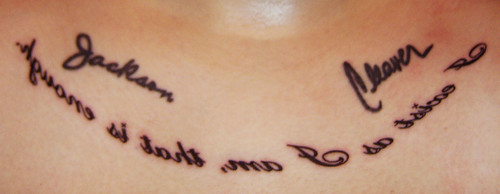
wwquotetattoo, originally uploaded by kawaface.
Like technology, the word text is difficult define as its meaning is altered depending upon context and form of communication. I found the definition of text provided by Florida State University, a good starting point to understanding the relationship between of text and technologies.
“Texts are material artifacts that take many different forms: cave paintings, tattoos, stone tablets, clay tablets, papyrus scrolls, manuscript books, musical scores, maps, printed books, engravings, newspapers, photographs, films, DVDs, computers. Every kind of text is produced by a special technology, but all those technologies share a simple purpose: they were designed to supplement the fragile human mind by providing a more durable artificial memory system. Those technologically preserved and transmitted memories are the foundation of all human culture”
(Emmerson et al., 2009, para. 1).
Prior to finding this definition I had never given much thought to tattoos as text. Emmerson et al. (2009) refer to technologies that produce text as “durable artificial memory system[s]”. Many people get tattoos as a permanent reminder of a special memory or person or a meaningful image, saying or word. Though I know many cultures use tattooing in traditional rituals, I had not considered the deeper implication of human skin as a vehicle for preserving and communicating information and memories. I choose the accompanying photo as it depicts tattoos of a person’s family names as well as a Walt Whitman quote – meaningful to the person whose skin it is preserved on.
References
Emmerson, R., Gontarski, S.E., Taylor, G., Walters, L., & Wiegand, W.A. (2009). Pathways to excellence: History of text technologies (HOTT) from cave paintings to personal computers. Retrieved September 13, 2009, from http://pathways.fsu.edu/faculty/hott/
September 14, 2009 No Comments
Text & Technology
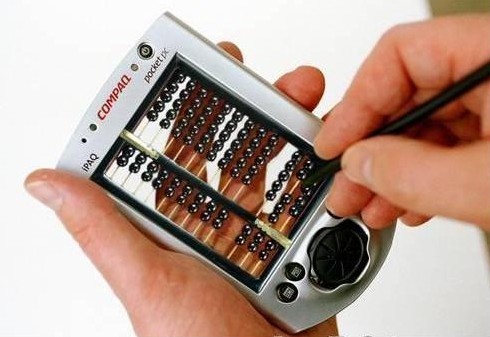
According to Chow, “The meaning of text involves writing and reading or, more appropriately, production and consumption. Production carries the intention of the author, while consumption is the process by which the reader makes meaning”.
A different approach to technology was explained by McLuhan as , “Technology is literally an extension of man, as the axe is an extension of the hand, the wheel of the foot. Most instruments are attempts to extend man’s physical capacity, a capacity shared with other animals. Communications technology, on the other hand, is an extension of thought, of consciousness, of man’s unique perceptual capacities. Thus communications media, broadly used to include all modes of symbolic representation, are literally extensions of mind”.
References
Chow, Kenny K. N. Operating Text and Transcending Machine: Toward an interdisciplinary Taxonomy of Media Works, LEONARDO, Vol. 41, No. 4, pp. 373-378, 2008.
Rosenthal, R. (ed), McLuhan Pro and Con, p 273, Baltimore: Penguin Books, 1968.
September 14, 2009 1 Comment
Technology as a System
seoul subway map, originally uploaded by oceandesetoiles.
Technology is an abstract concept that is multi-faceted and is therefore difficult to describe. Lorenzo Simpson (1995) defines technology as a “constellation of knowledge, processes, skills and products whose aim is to control and transform” (p. 16). To expand on this, Franklin (1999) believes that “technology is a system that goes beyond individual material components – it “involves organization, procedures, symbols, new words, equations, and most of all, a mindset” (p. 3). According to Murphie and Potts (2003) technology also involves cultural values, ideologies, ethical concerns and is shaped by political and economic determinants (p. 4).
In thinking of technology as a system I chose an image of the Seoul subway map. The subway is a system that works to control the movement of people across the city. The map looks complex however it is based on an organized system that relies on procedures, processes, knowledge and symbols. Culturally, the subway system is woven into the everyday lives of many individuals. Ethically, public transport allows us to be more environmentally friendly. Economically, public transport is an affordable way to travel. Ultimately, the subway map illustrates how many small and simple systems (routes) can work together to form a more complex whole.
References
Franklin, U. M. (1999). The real world of technology. Toronto: House of Anansi Press, Inc.
Murphie, A., & Potts, J. (2003). Culture and technology. New York: Palgrave Macmillan.
Simpson, L. (1995). Technology and the conversations of modernity. New York: Routledge.
September 14, 2009 1 Comment
Library 2.0 searching for meaning
Hi everyone,
After reading through the WordPress entries today, I found that most of the passages I wanted to use had already been quoted. As a result, to find a short passage that gives meaning to the word text I decided to try my luck using the “Great Library 2.0”, i.e. Google Books, using the search terms “defining text”. I expected to find a deep, philosophical quote that would WOW you all. Well, I was indeed, surprised by the results. Of the top twenty hits, thirteen were in some way related to computer programming or desktop publishing software. I then tried a more refined search by looking for the exact phrase “defining text” (I did not use quotations the first time). This actually increased the number of computer related books to sixteen. “Define text” resulted in sixteen as IT results as well. Many searches later, I tried searching for “the origins of text”. Finally I started seeing some relevant results. However, there were still results for Unix and a text-mining computer application.
While the search results alone do not provide a passage that gives meaning to the word text, I think that the results shed light on the changing definition of the word text in the information age. The word text has become synonymous with the inventions of the digital age: text as a programming language, text as the basis for word processing, text as the foundation of the World Wide Web, etc. This was also stressed by O’Donnell and Engell when discussing the impacts that technology has had on education and on today’s youth, especially in regards to new language developing in text and e-mail. Technology not only redefines and revolutionizes text, it also reshapes the way interact with text and changes and reinvents the media through which we use it to communicate.
John
September 14, 2009 No Comments
What isn’t technology?
After reading and thinking (and dreaming!) about the definition of technology, I have come up with this:
Technology is tools, skills and techniques that we use to control and shape our environment.
Which leads me to two questions:
- Obviously writing is technology, but is language itself also technology?
- Is there anything that isn’t technology?
That is as far as I can get on my own. I now look forward to entering into the debate.
Dilip Verma
September 14, 2009 1 Comment
Technology – tool or lifestyle choice?
Technology is an indicator of intellectual progress. When I think of technology, I picture grinding gears, the industrial revolution. It never occurred to me before I read O’Donnell, that the simple invention of writing, the simplest of technologies, was to cause an irreversible change in the history of our civilization.
I have used technology to make my classes more lively and relevant. I’ve used it to teach useful work skills to my students. But I have never, until now, considered the far reaching effects of technology. It seems that whatever it touches cannot remain unchanged.
Our society pursues all things technological. We’ve been convinced that our life cannot be fulfilled without increasingly sophisticated electronic objects. Cell phones for children, Baby Einstein movies for mental stimulation of infants; the language of technology is so pervasive that we are being told to “upgrade” our lives. Visit the following link to view Oprah.com’s take on this: http://www.oprah.com/article/home/homeimprovement/pkgupgradeyourlife/20090401-orig-upgrade-your-life-landing
Next birthday, when I am asked how old I am, I’ll answer “I’m a version 5.2”.
September 14, 2009 No Comments
Weaving tales
Words fascinate me and I love discovering where they come from. I had a little problem with text, as I remember my grandfather telling me of how in Ireland people were renowned for weaving tales and so weaving and woven were common words for me related to oral storytelling. I had never related them with the written word before, however on reflection it does make sense. Technology was more of a challenge. I had never considered the anthropological definition of technology as “a body of knowledge”. It seems so all encompassing. This would mean therefore that any new knowledge we have could be considered as technology and from there I must accept that all technology will cause changes whether we make them consciously or not.
Web Site
Definition of technology Dictionary.com retrieved on the 14th of September 2009 from
September 14, 2009 No Comments
Technology?
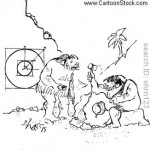
Contrary to popular belief, technology does not refer solely to computers. Technology is any instrument, machine, tool, weapon or appliance carrying out a purpose. The wheel, for example, was an ancient technology that revolutionized transport and changed the world. Technology is constantly improving and transforming into something more superior than their predecessors.
In many ways, science and technology are closely related and dependent upon each other. In the cartoon above, science appears to be “perfect”; however, the actual technology or creation did not measure up to the theory thus leaving a gap between the two fields.
Carmen Chan
September 14, 2009 No Comments
Technology comic relief
September 14, 2009 No Comments
Fabric a metaphor for text…
I have to admit that I was more interested at examining technology than text, but when I started reading the etymology of text from the Oxford English Dictionary I was immediately drawn in. My initial thoughts of simple written words were expanded by the latin root of textus – “that which is woven, web, texture” (Oxford English Dictionary). As a Home Ec teacher this caught my interest as I compared written work to that of woven fabric; both have depth, complexity and pose interest. Also, both text and fabric have wide ranging uses that are open for interpretation.
Sarah
September 14, 2009 No Comments
Meaning of Text
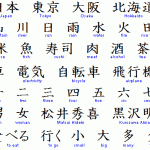
Text is any written language or series of symbols that contain meaning. The collection can be printed, engraved or painted as long as it is readable then it is considered as text. Hieroglyphs is an example of text. Electronic text is a version of the written word. Texting is the transfer of text.
The image above is a sample of Japanese texts or symbols used alone or in combination for communication. As time progresses, text and its meanings undergo transformations. Text is constantly being invented and introduced as humans progress and require extra texts to communicate effectively.
Carmen Chan.
September 14, 2009 No Comments

